Sapphire Radeon HD 7950 OC 3 GB Graphics Card Review

Today we are going to review a graphics accelerator with a phenomenally efficient cooling system with very low noise, high performance and superb overclocking potential, which even some Radeon HD 7970 graphics cards could wish for.
Following the release of its 28nm Tahiti GPU and the first Radeon HD 7970 3GB graphics card, AMD announced the more affordable, yet also high-end, product known as Radeon HD 7970 3GB. One of the first companies to introduce an original version of the latter card is the legendary Sapphire Technology. Its product comes under a rather unassuming name of Sapphire Radeon HD 7950 OC 3GB but is actually one of the most exciting Tahiti Pro based graphics cards available. What is especially nice is that it has come about right after the official launch of the Radeon HD 7950.

Sapphire’s promo banner suggests that the new card is overclocker-friendly thanks to its multi-heatpipe Dual-X cooler and two BIOS chips, one of which contains more aggressive cooler settings. We’ll talk about all these and many other features in this review.
Technical Specifications
The table below contains technical specifications of Sapphire Radeon HD 7950 OC graphics cards in comparison with the reference AMD Radeon HD 7970 and HDm7950:
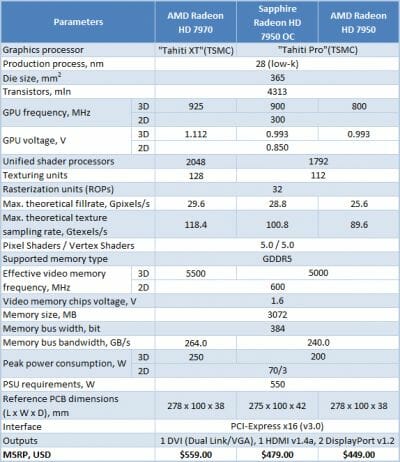
Packaging and Accessories
The Sapphire Radeon HD 7950 OC is shipped in a cardboard box that has a picture of a full-bosomed girl, masked and armed, on its face side.
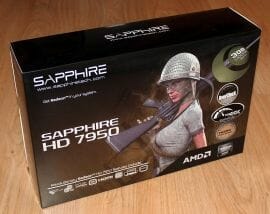
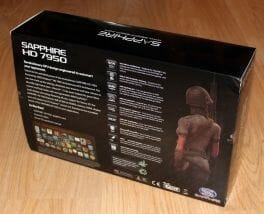
The key features of the card are listed nearby and you can note that the product is Overclock Edition. Those features are detailed on the back of the box and accompanied with a long list of awards from online and print media that Sapphire has collected.
Sealed in a soft pack, the graphics card lies in the central compartment of the box. A smaller flat box with accessories can be found underneath.
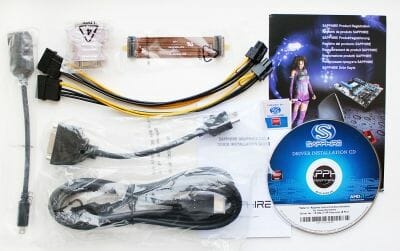
The accessories include everything necessary to use the card: two power cables, a mini-DisplayPort->DisplayPort adapter, an HDMI->DVI-I (single-link) adapter, a 1.8-meter HDMI 1.4a cable, a DVI->D-Sub adapter, a CrossFireX bridge, a CD with drivers, a user manual, and even a sticker with Sapphire logo. There are no free games in the box but that’s a common trend nowadays among all graphics card makers with rare exceptions.
The retail price of the Sapphire Radeon HD 7950 OC is $479. The warranty period is 2 years.
PCB Design
The graphics card we are testing today resembles Sapphire’s Radeon HD 6970 2GB Dual Fan which has the same cooler. Probably to avoid confusion, Sapphire wrote this card’s model name right on the plastic casing.
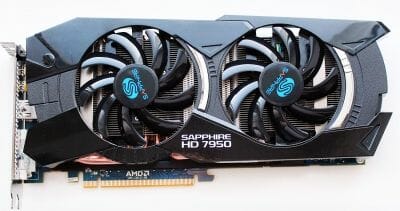
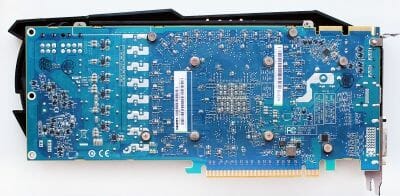
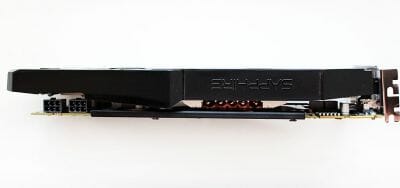
The sculpted casing has acquired two chrome inserts at the sides of the fans. The card is 275 millimeters long. Its height and width are 100 and 42 millimeters, respectively.
Like the reference AMD Radeon HD 7950, the Sapphire Radeon HD 7950 OC offers one dual-link DVI-I port, one HDMI 1.4a connector and two DisplayPorts version 1.2.
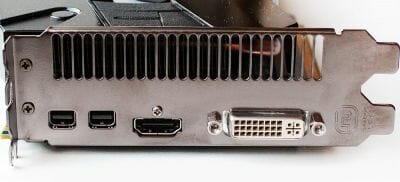
This cooler doesn’t really need a large vent grid in the card’s mounting bracket, but Sapphire didn’t install a second DVI-I connector at the expense of the grid. This is not a big problem considering the included adapter, though.
The power and MIO connectors and the dual BIOS are all the same as on the reference Radeon HD 7950.
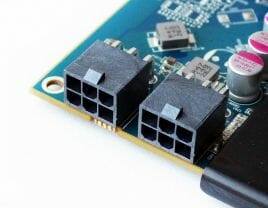
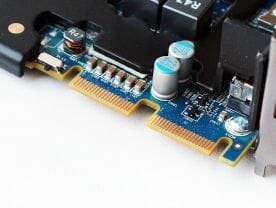
We can see two 6-pin power connectors, two MIO connectors for CrossFireX configurations and a switch for choosing the BIOS to use. The peak power consumption of the Radeon HD 7950 in 3D mode is declared to be 200 watts. It is going to lower to 70 watts in 2D mode and to 3 watts when the monitor is turned off. Considering the pre-overclocked GPU frequency, the Sapphire card is going to need somewhat more power than the reference sample, but not by much.
Two BIOSes are available with the Sapphire Radeon HD 7950 OC 3GB. One has more aggressive fan settings so that the cooler could handle the GPU and power components more effectively at increased frequencies and voltages.
With all of the cooler’s elements removed, the card looks like that:
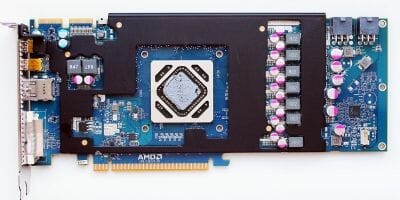
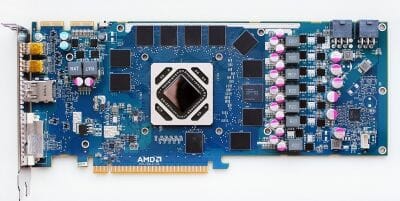
The power system consists of six phases for the GPU and 2+1 phases for the memory chips and voltage converter.
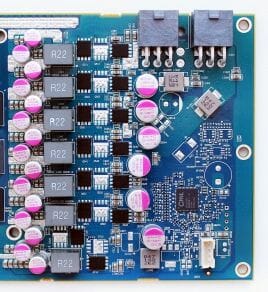
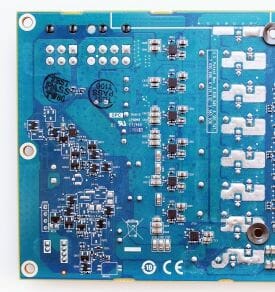
In fact, the Radeon HD 7950 has the same power circuit as the HD 7970 but lacks high-quality DirectFETs. It employs the same controller CHiL CHL8228G, though.
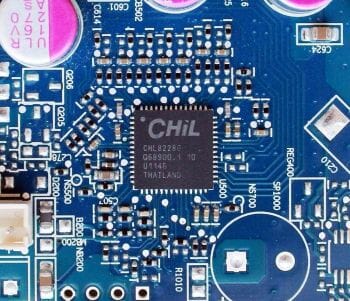
The 28nm Tahiti Pro chip lacks any marking:
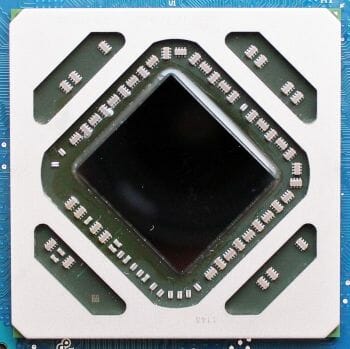
It has a standard Radeon HD 7970 configuration with 1792 unified shader processors, 32 raster back-ends and 112 texture-mapping units. The Sapphire Radeon HD 7950 OC has a GPU clock rate of 900 MHz at 0.993 volts in 3D mode. The frequency is lowered to 300 MHz at 0.850 volts in 2D mode. Thus, Sapphire’s factory overclocking amounts to a hefty 100 MHz here.
Like its senior cousin, the Radeon HD 7950 is equipped with 3 gigabytes of GDDR5 memory in 12 FCFBGA-packaged chips located on the face side of the PCB and manufactured by Hynix Semiconductor. They are labeled as H5GQ2H24MFR T2C.
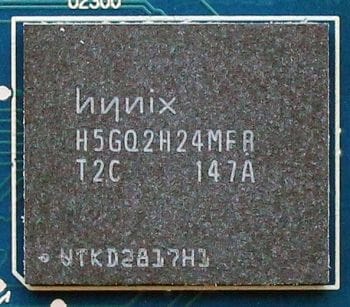
The rated clock rate of such chips is 5500 MHz in 3D mode but, like the reference Radeon HD 7950, the Sapphire clocks its memory at 5000 MHz with a voltage of 1.6 volts. It’s a shame since the chips do have tremendous potential as you will see shortly. The memory bus is 384 bits wide, providing a bandwidth of 240 GB/s. The card drops its memory frequency to 600 MHz in 2D mode.
Using GPU-Z, we determined the “quality level” of the GPU of our sample of the card. It is not very high at 76.1%.
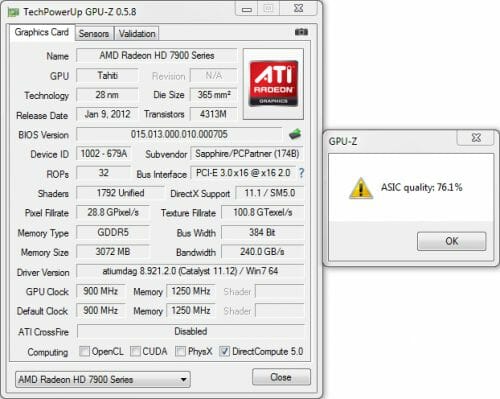
Cooling System and Noise Level
The cooling system of the Sapphire Radeon HD 7950 OC is almost a perfect copy of the cooler of the Sapphire Radeon HD 6970 DualFan but is now called Dual-X:
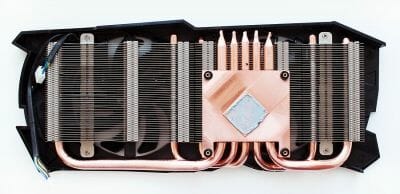
Its aluminum heatsink is based on five heat pipes, three of which are 6 millimeters in diameter. The two outermost pipes are 8 millimeters in diameter.
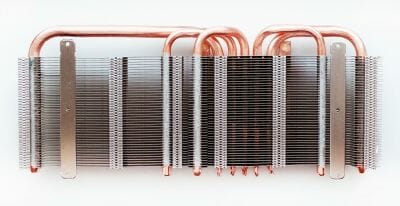
The heat pipes are soldered to the copper base which has a special protrusion for the GPU die:
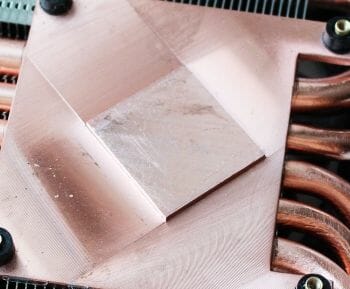
This is in fact the only difference of the Dual-X cooler from its DualFan predecessor except for the metallic frame for the memory chips and power components:
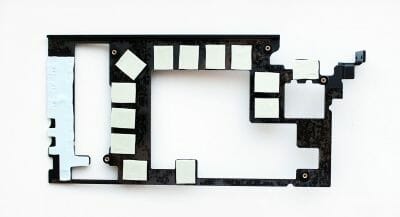
The two 90mm fans are secured within the cooler’s plastic casing:
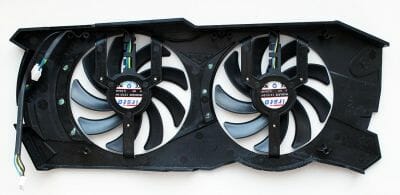
Like the Sapphire Radeon HD 6970’s cooler, this one employs FirstDFD7010H fans.
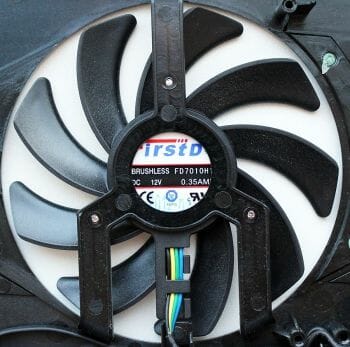
The speed is PWM-regulated within a range of 1100 to 3200 RPM. The peak power consumption of each fan is 4.2 watts.
We checked out the card’s temperature while running Aliens vs. Predator (2010) in five cycles at the highest settings (2560×1600, with 16x anisotropic filtering and 4x full-screen antialiasing). We used MSI Afterburner 2.2.0 Beta 12 and GPU-Z 0.5.8 as monitoring tools. This test was carried out with a closed system case at an ambient temperature of 26°C. We didn’t change the card’s default thermal interface.
Let’s see how efficient Sapphire’s cooler is with its fans being regulated automatically and at their maximum speed:
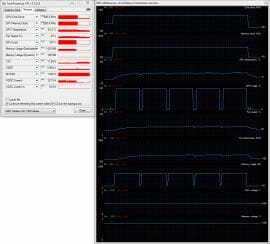
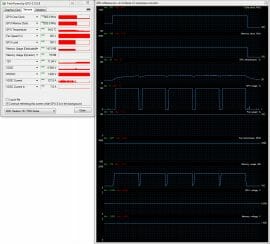
When regulated automatically, the fans have a peak speed of 1800 RPM and the GPU temperature is only 63°C. At the maximum speed of the fans the GPU is no hotter than 54°C. This is an excellent result, especially as the GPU is pre-overclocked by 100 MHz. We knew the cooler to be effective after our tests of the Sapphire Radeon HD 6970 DualFan and it proves its efficiency once again on the new card. By the way, when we switched to the second BIOS (the more extreme version according to Sapphire), the cooler’s fans would work at the same speeds. The card didn’t seem to think it necessary to speed the fans up under our test conditions. Now, what about the noise factor?
We measured the level of noise using an electronic noise-level meter CENTER-321 in a closed room about 20 sq. meters large. The noise-level meter was set on a tripod at a distance of 15 centimeters from the graphics card which was installed on an open testbed. The mainboard with the graphics card was placed at an edge of a desk on a foam-rubber tray. The lower limit of our noise-level meter is 29.8 dBA whereas the subjectively comfortable (not low, but comfortable) level of noise when measured from that distance is about 36 dBA. The speed of the graphics card’s fans was being adjusted by means of a controller that changed the supply voltage in steps of 0.5 V.
We’ve included the results of the reference AMD Radeon HD 7970 and the Sapphire Radeon HD 6970 Dual Fan cooler into the next diagram. Here are the results:
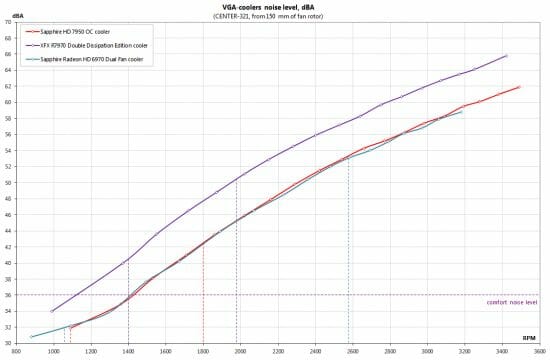
As we can see, the noise curve for Sapphire Radeon HD 7950 OC repeats traces the curve of the Sapphire Radeon HD 6970 Dual Fan, which is quite logical, because the coolers differ only by the decorative inserts and “shields”. Nevertheless, the new Sapphire graphics card works much quieter, because the maximum speed of its cooling fans in automatic mode is 1800 RPM, while Sapphire Radeon HD 6970 Dual Fan has a higher maximum of 2580 RPM. In 2D mode the graphics card cooler is completely undetectable against the background of the quiet system case. The cooler of XFX R7970 Double Dissipation Edition produces more noise.
Overclockability
We know that AMD Radeon HD 7970s have very high overclocking potential. Moreover, their performance increases proportionally to their GPU frequency. Is the junior Tahiti Pro good in this respect, too? Frankly speaking, we were annoyed at being able to increase the clock rate of our Sapphire Radeon HD 7950 OC to no higher than 940 MHz at first attempt:
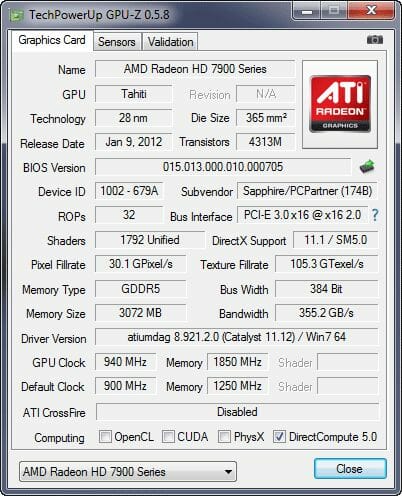
Well, that’s not so bad, actually. The frequency is 17.5% higher than that of the reference AMD Radeon HD 7950 and the temperature doesn’t grow much:
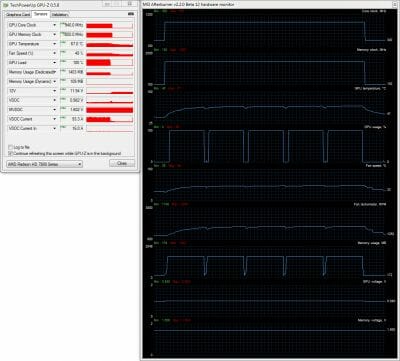
But of course we had expected something better, especially as the card features such an efficient cooler.
Therefore we increased the GPU voltage from its default 0.993 to 1.2 volts and continued our overclocking experiment. At a GPU clock rate of 1150 MHz the Sapphire card could pass through most of our tests but showed some visual artifacts in certain games (Aliens vs. Predator (2010) and Metro 2033). So we had to roll back to 1100 MHz, which was far better than the original 940 MHz at the default voltage. Then we started to lower the voltage, finding the balance between frequency, voltage and stability at 1.15 volts and 1100 MHz (+37.5%).
The memory chips could be overclocked easily to 7360 MHz (+47.2%).
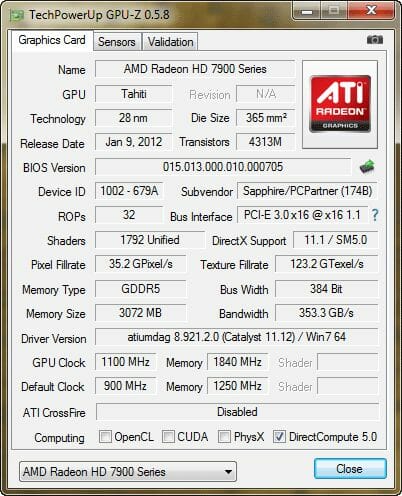
The GPU temperature of the overclocked card was 74°C under peak load, the fan speed being fixed at 75% or 3000 RPM.
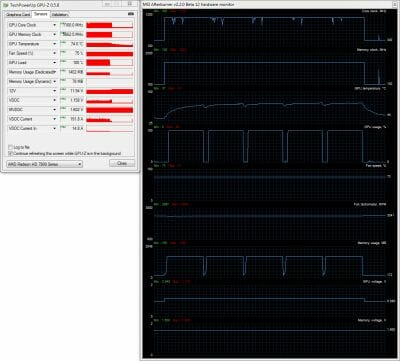
At a lower speed of the fans the cooler couldn’t cope with the overclocked card, provoking visual artifacts and instability in games and benchmarks. Anyway, our sample of the Sapphire Radeon HD 7950 OC card proved to have very high overclocking potential.
Power Consumption
We measured the power consumption of computer systems with different graphics cards using a multifunctional panel Zalman ZM-MFC3 which can report how much power a computer (the monitor not included) draws from a wall socket. There were two test modes: 2D (editing documents in Microsoft Word and web surfing) and 3D (the benchmark from Metro 2033: The Last Refuge at 1920×1080 with maximum settings). Here are the results:
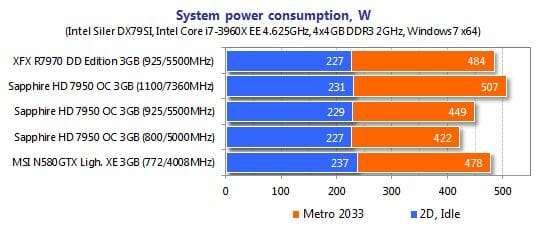
The systems with different graphics cards are close in power consumption in 2D mode, the overclocked six-core CPU being the more important factor. But when it comes to 3D applications, the GeForce GTX 580 system needs about 56 watts more than the Radeon HD 7950 configuration. The latter also needs 62 watts less than the Radeon HD 7970 system.
Interestingly, the HD 7950 needs 35 watts less even when clocked at the same frequencies as the HD 7970. Well, this difference can hardly be noticed in your electricity bill anyway.
Testbed Configuration and Testing Methodology
All graphics cards were tested in a system with the following configuration:
- Mainboard: Intel Siler DX79SI (Intel X79 Express, LGA 2011, BIOS 0380 from 11/28/2011);
- CPU: Intel Core i7-3960X Extreme Edition, 3.3 GHz, 1.2 V, 6 x 256 KB L2, 15 MB L3 (Sandy Bridge-E, C1, 32 nm);
- CPU cooler: Phanteks PH-TC14PE (2 x 140 mm fans at 900 RPM);
- Thermal interface: ARCTIC MX-4;
- System memory: DDR3 4 x 4GB Mushkin Redline (Spec: 2133 MHz / 9-11-10-28 / 1.65 V);
- Graphics cards:
- XFX R7970 Double Dissipation Edition 3 GB/384 bit GDDR5, 925/5500 MHz;
- Sapphire Radeon HD 7950 OC 3 GB/384 bit GDDR5, 800/5000 MHz, 925/5500 MHz and 1100/7360 MHz;
- MSI N580GTX Lightning Xtreme Edition 3 GB/384 bit GDDR5, 772/1544/4008 MHz;
- System drive: Crucial m4 256 GB SSD (SATA-III,CT256M4SSD2, BIOS v0009);
- Drive for programs and games: Western Digital VelociRaptor (300GB, SATA-II, 10000 RPM, 16MB cache, NCQ) inside Scythe Quiet Drive 3.5” HDD silencer and cooler;
- Backup drive: Samsung Ecogreen F4 HD204UI (SATA-II, 2 TB, 5400 RPM, 32 MB, NCQ);
- System case: Antec Twelve Hundred (front panel: three Noiseblocker NB-Multiframe S-Series MF12-S2 fans at 1020 RPM; back panel: two Noiseblocker NB-BlackSilentPRO PL-1 fans at 1020 RPM; top panel: standard 200 mm fan at 400 RPM);
- Control and monitoring panel: Zalman ZM-MFC3;
- Power supply: Xigmatek “No Rules Power” NRP-HC1501 1500 W (with a default 140 mm fan);
- Monitor: 30” Samsung 305T Plus.
These are the competitors for Sapphire Radeon HD 7950 OC in our today’s test session:
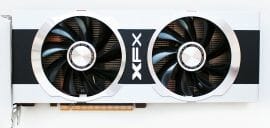
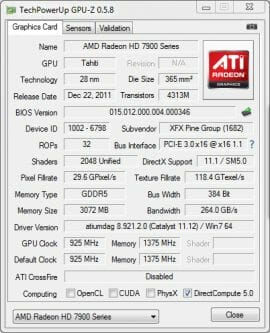
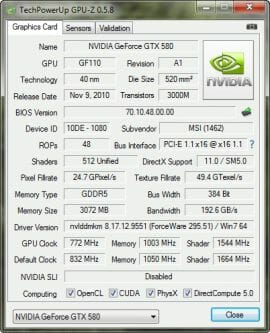
In order to lower the dependence of the graphics cards performance on the overall platform speed, I overclocked our 32 nm six-core CPU with the multiplier set at 37x, BCLK frequency set at 125 MHz and “Load-Line Calibration” enabled to 4.625 GHz. The processor Vcore was increased to 1.45 V in the mainboard BIOS:
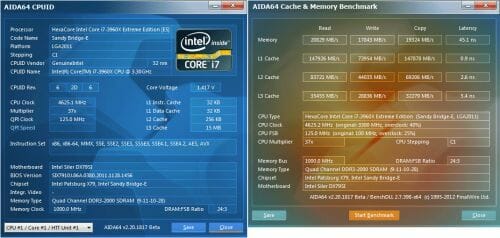
Hyper-Threading technology was enabled. 16 GB of system DDR3 memory worked at 2.133 GHz frequency with 9-11-10-28 timings and 1.65V voltage.
The test session started on January 31, 2012. All tests were performed in Microsoft Windows 7 Ultimate x64 SP1 with all critical updates as of that date and the following drivers:
- Intel Chipset Drivers 9.3.0.1019 WHQL from 12/22/2011 for the mainboard chipset;
- DirectX End-User Runtimes libraries from November 30, 2010;
- AMD Catalyst 11.12 (8.921.2 RC11) driver from 01/25/2012 + Catalyst Application Profile (CAP3) from 01.18.2012 for AMD based graphics cards;
- Nvidia GeForce 295.51 beta from 01/31/2012 for Nvidia based graphics cards.
The graphics cards were tested in two resolutions: 1920×1080 and 2560×1600. The tests were performed in two image quality modes: “Quality+AF16x” – default texturing quality in the drivers with enabled 16x anisotropic filtering and “Quality+ AF16x+MSAA4(8)x” with enabled 16x anisotropic filtering and full screen 4x anti-aliasing (MSAA) or 8x if the average framerate was high enough for comfortable gaming experience. We enabled anisotropic filtering and full-screen anti-aliasing from the game settings or configuration files. If the corresponding options were missing, we changed these settings in the Control Panels of Catalyst and GeForce drivers. We also disabled Vsync there. There were no other changes in the driver settings.
The list of games and applications used in this test session includes two popular semi-synthetic benchmarking suites, one technical demo and 15 games of various genres:
- 3DMark Vantage (DirectX 10) – version 1.0.2.1, Performance and Extreme profiles (only basic tests);
- 3DMark 2011 (DirectX 11) – version 1.0.3.0, Performance and Extreme profiles;
- Unigine Heaven Demo (DirectX 11) – version 2.5, maximum graphics quality settings, tessellation at “extreme”, AF16x, 1920×1080 resolution with MSAA 4x;
- S.T.A.L.K.E.R.: Call of Pripyat (DirectX 11) – version 1.6.02, Enhanced Dynamic DX11 Lighting profile with all parameters manually set at their maximums, we used our custom cop03 demo on the Backwater map;
- Left 4 Dead 2 (DirectX 9) – version 2.0.8.8, maximum graphics quality settings, d81 demo (two runs) on “Gold Stream (Beta)” map of the “Alpine Greek” level;
- Metro 2033: The Last Refuge (DirectX 10/11) – version 1.2, maximum graphics quality settings, official benchmark, “High” image quality settings; tesselation, DOF and MSAA4x disabled; AAA aliasing enabled, two consecutive runs of the “Frontline” scene;
- Just Cause 2 (DirectX 11) – version 1.0.0.2, maximum quality settings, Background Blur and GPU Water Simulation enabled, two consecutive runs of the “Dark Tower” demo;
- Aliens vs. Predator (2010) (DirectX 11) – Texture Quality “Very High”, Shadow Quality “High”, SSAO On, two test runs in each resolution;
- Lost Planet 2 (DirectX 11) – version 1.0, maximum graphics quality settings, motion blur enabled, performance test “B” (average in all three scenes);
- StarCraft 2: Wings of Liberty (DirectX 9) – version 1.4.2, all image quality settings at “Extreme”, Physics at “Ultra”, reflections On, two 2-minute runs of our own “bench2” demo;
- Sid Meier’s Civilization V (DirectX 11) – version 1.0.1.348, maximum graphics quality settings, two runs of the “diplomatic” benchmark including five heaviest scenes;
- Tom Clancy’s H.A.W.X. 2 (DirectX 11) – version 1.04, maximum graphics quality settings, shadows On, tessellation Off (not available on Radeon), two runs of the test scene;
- Total War: Shogun 2 (DirectX 11) – version 2.0, built in benchmark (Sekigahara battle) at maximum graphics quality settings;
- Crysis 2 (DirectX 11) – version 1.9, we used Adrenaline Crysis 2 Benchmark Tool v.1.0.1.13. BETA with “Ultra High” graphics quality profile and activated HD textures, two runs of a demo recorded on “Times Square” level;
- DiRT 3 (DirectX 11) – version 1.2, built-in benchmark at maximum graphics quality settings on the “Aspen” track;
- Hard Reset Demo (DirectX 9) – benchmark built into the demo version with Ultra image quality settings, one test run;
- Batman: Arkham City (DirectX 11) – version 1.2, maximum graphics quality settings, physics disabled, two sequential runs of the benchmark built into the game.
- Battlefield 3 (DirectX 11) – version 1.3, all image quality settings set to “Ultra”, two successive runs of a scripted scene from the beginning of the “Going Hunting” mission 110 seconds long.
If the game allowed recording the minimal fps readings, they were also added to the charts. We ran each game test or benchmark twice and took the best result for the diagrams, but only if the difference between them didn’t exceed 1%. If it did exceed 1%, we ran the tests at least one more time to achieve repeatability of results.
Performance Tests
So, what products are we going to compare today? First of all, we are going to benchmark Radeon HD 7970 and HD 7950 cards at their default frequencies of 925/5500 and 800/5000 MHz, respectively. Then, we will also compare them at the identical frequencies of 925/5500 MHz to check out the effect of the lack of some functional subunits in the Tahiti Pro processor. We will also overclock our HD 7950 to its limit to see if it can beat the HD 7970. And finally, we will compare the Radeon HD 7950 with the GeForce GTX 580 at the latter’s default clock rates. Let’s get started!
3DMark Vantage
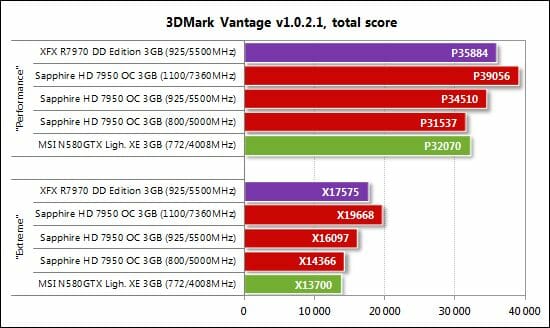
3DMark 2011
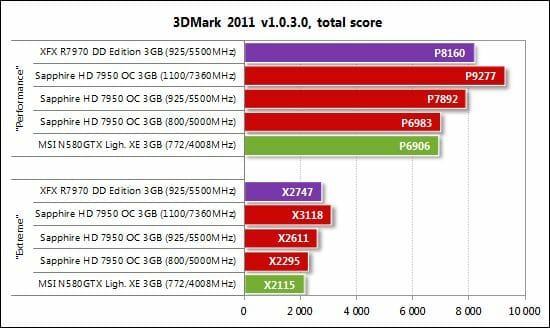
Both benchmarks from Futuremark produce the same standings. The Radeon HD 7950, when clocked at its default frequencies, is as fast as the GeForce GTX 580 and 14-22% slower than the Radeon HD 7950. The HD 7950 is as close as 3-9% to its senior cousin when overclocked to 925/5500 MHz and leaves it behind by 8-12% at the maximum frequencies.
Unigine Heaven Demo
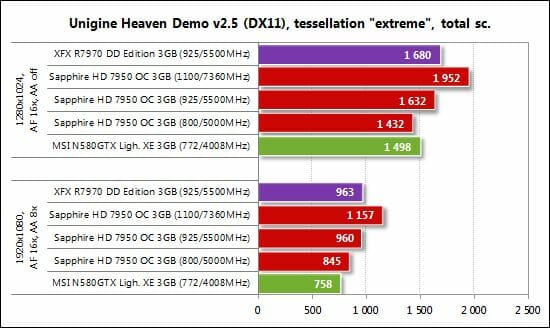
The difference between the Radeon HD 7970 and HD 7950 is very small when both are clocked at 925/5500 MHz. The latter card enjoys an impressive advantage when overclocked to 1100/7360 MHz.
S.T.A.L.K.E.R.: Call of Pripyat
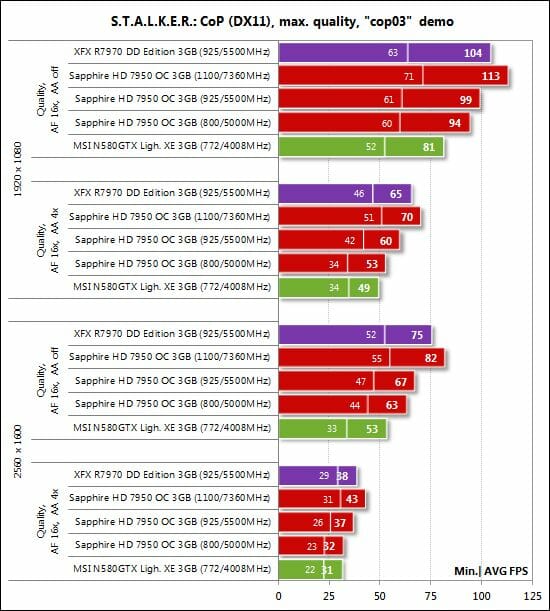
The HD 7950 falls behind the HD 7970 when both work at the same frequencies in S.T.A.L.K.E.R.: Call of Pripyat. The gap is even larger at 23% when both work at their default clock rates. It is only through maximum overclocking that the Sapphire card goes ahead. The GeForce GTX 580 is slower than the Sapphire across all the test modes.
Left 4 Dead 2
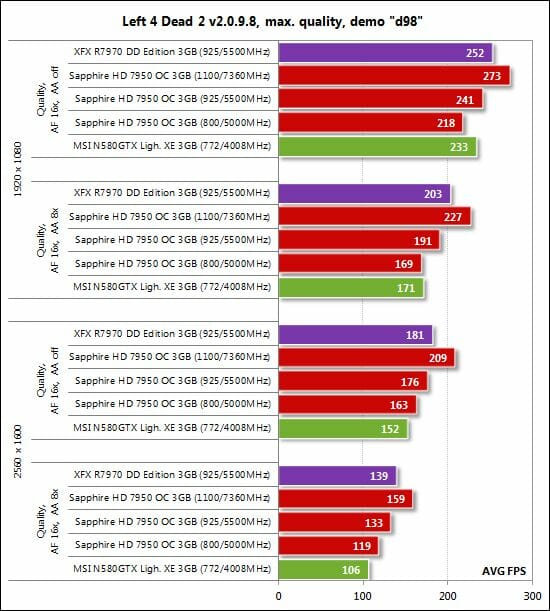
The graphics cards deliver very high frame rates in Left 4 Dead 2, so we should compare them at 2560×1600 with 8x antialiasing: the Radeon HD 7950 is somewhat faster than the GeForce GTX 580, slower than the HD 7970 at the same clock rates, and leaves every opponent behind when overclocked to maximum frequencies.
Metro 2033: The Last Refuge
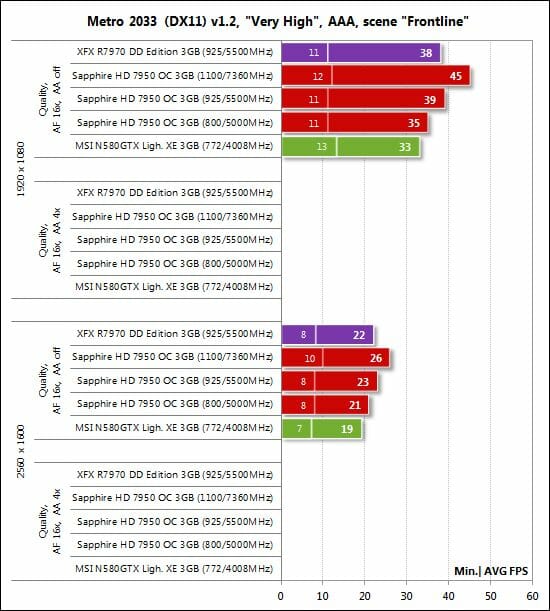
The game produced the same results irrespective of whether we enabled FSAA or not. Therefore we tested the graphics cards in the FSAA-less mode only.
This game can only run smoothly on top-end CrossFireX and SLI configurations. You won’t get a comfortable frame rate with a single graphics card, even a top-end one. The standings are the same as in the previous tests, though.
Just Cause 2
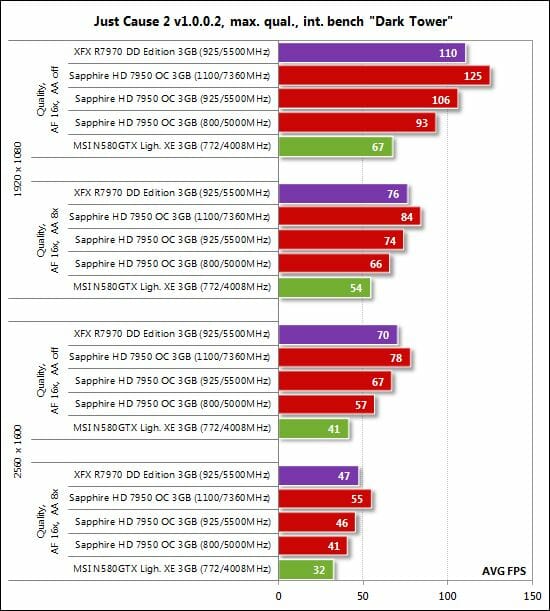
Aliens vs. Predator (2010)
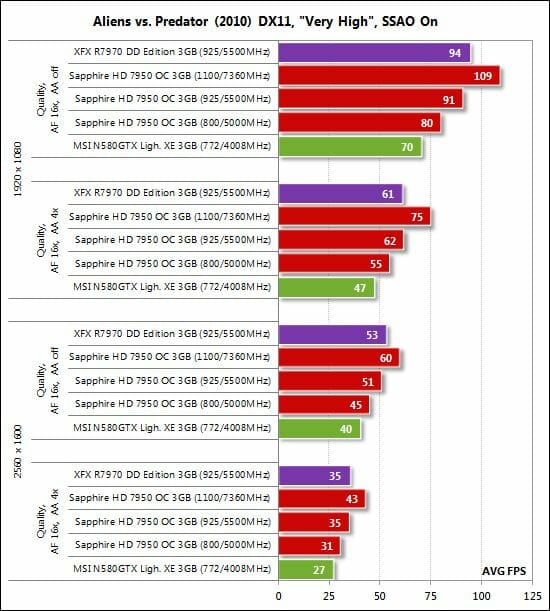
Just Cause 2 and Aliens vs. Predator (2010) produce the same standings.
Lost Planet 2
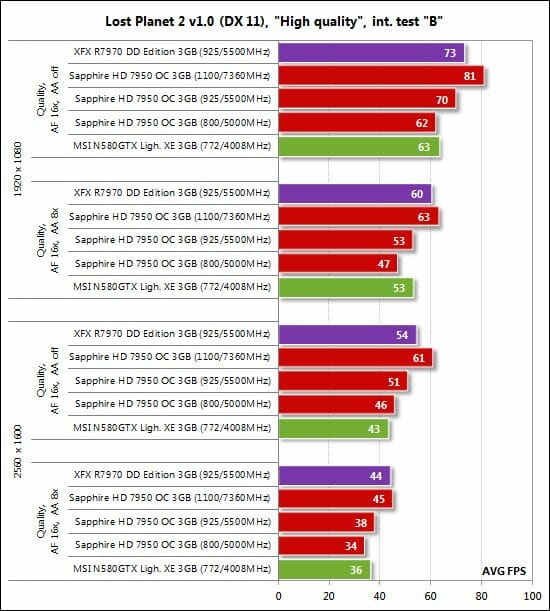
The GeForce GTX 580 beats the Radeon HD 7950 in Lost Planet 2 when the latter card works at its default clock rates. The Sapphire overtakes the MSI as soon as we overclock it to 925/5500 MHz and comes out the winner of the test, just like elsewhere in this test session, at the highest clock rates.
StarCraft II: Wings of Liberty
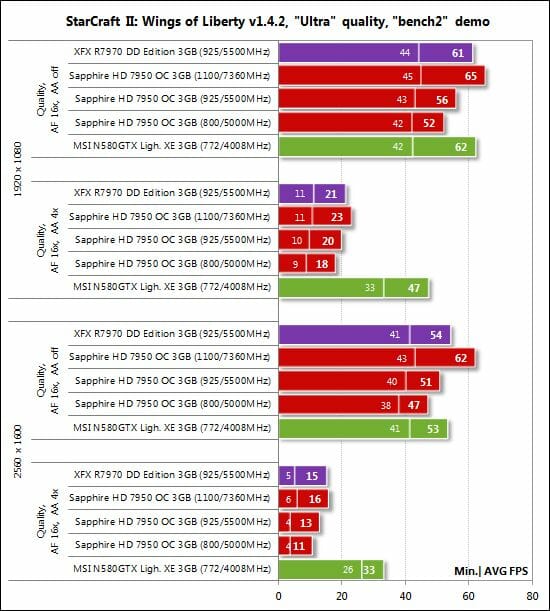
AMD-based cards are still very slow in this game when you turn on antialiasing whereas Nvidia-based products feel at their ease. Therefore, we can only see some competition in the MSAA-less mode but the GeForce GTX 580 wins anyway. It is only when well-overclocked that the Radeon HD 7950 can beat the GTX 580 together with the HD 7970.
Sid Meier’s Civilization V
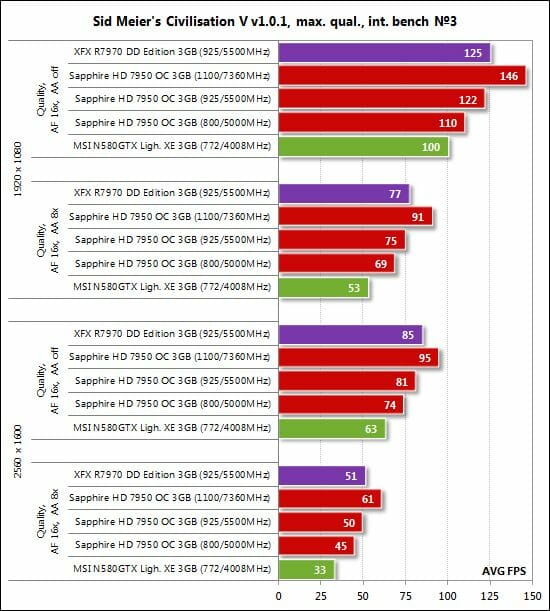
The Radeons perform normally again. Take note the minimum difference between the Radeon HD 7950 and HD 7970 at the same clock rates.
Tom Clancy’s H.A.W.X. 2
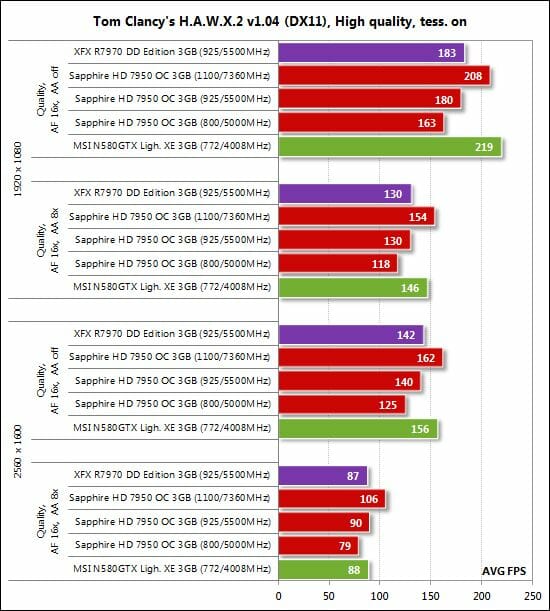
The GeForce GTX 5xx series is traditionally strong in this flight sim whereas the two Radeons have the same standings as in most of the previous tests.
Total War: Shogun 2
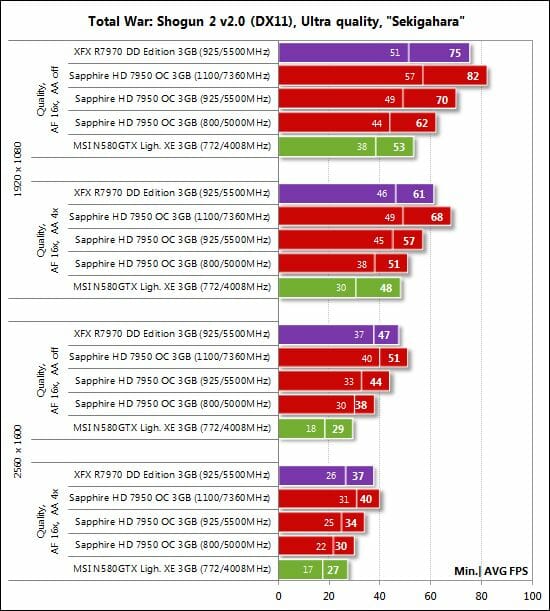
The AMD team retaliates after their defeat in Tom Clancy’s H.A.W.X. 2. The Radeon HD 79xx series cards meet no competition in Total War: Shogun 2 and Crysis 2:
Crysis 2
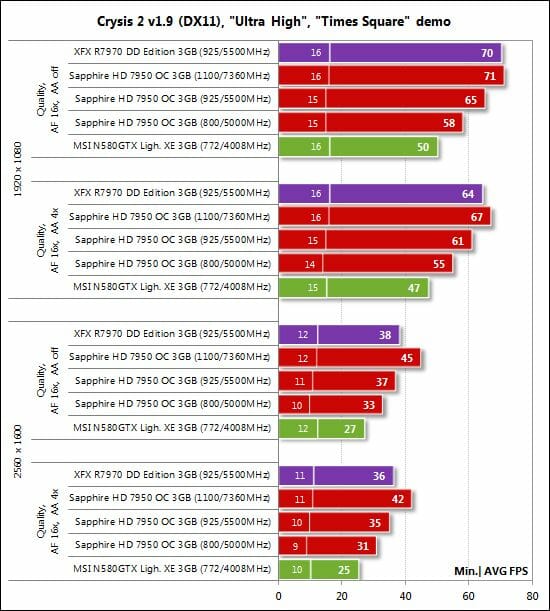
DiRT 3
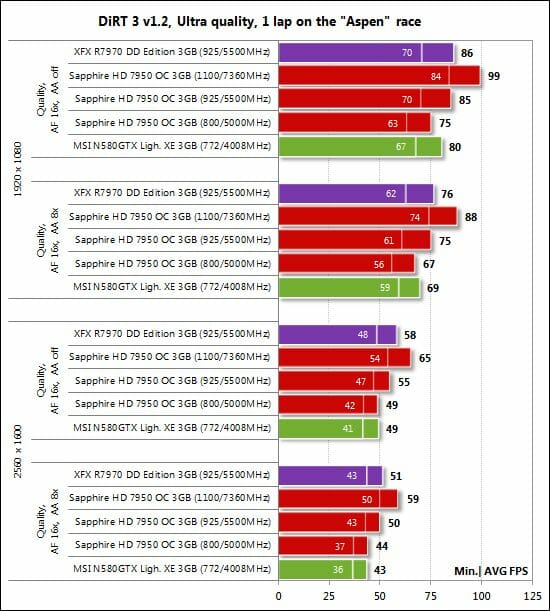
There is almost no difference between the Radeon HD 7950 and GeForce GTX 580 in DiRT 3 except that the latter card is somewhat faster at 1920×1080. There is also little difference between the Radeon HD 7970 and HD 7950 at 925/5500 MHz. The HD 7950 wins the test when overclocked to 1100/7360 MHz.
Hard Reset Demoa
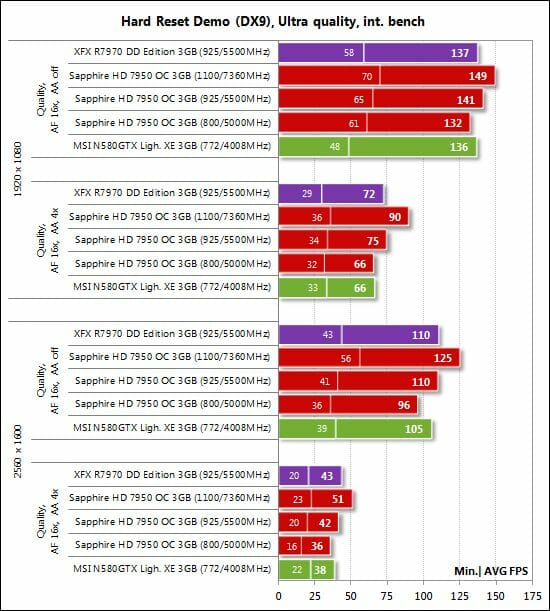
The graphics cards are closer to each other in Hard Reset Demo. The GeForce GTX 580 is somewhat better than the Radeon HD 7950 (800/5000 MHz) across all the test modes, yet the difference is small, just like between the two Radeons when they work at the same clock rates.
Batman: Arkham City
It’s like in the previous test:
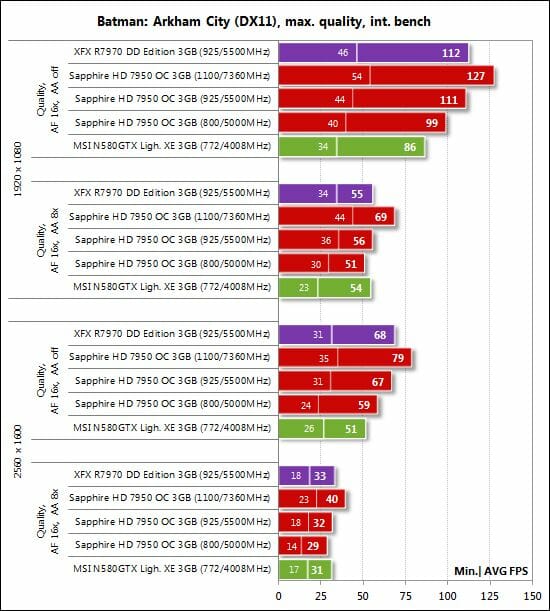
Battlefield 3
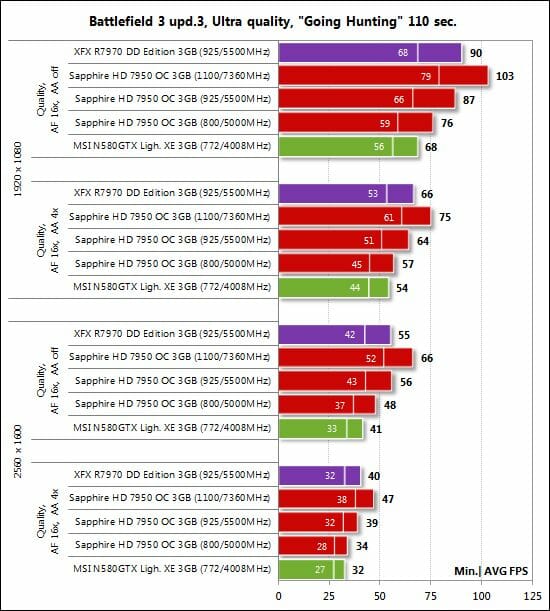
Battlefield 3 doesn’t have anything new to tell us, so let’s move on to summary diagrams.
Performance Summary
First, let’s check out the difference between the Radeon HD 7970 3GB (925/5500 MHz) and the Radeon HD 7950 3GB (800/5000 MHz):
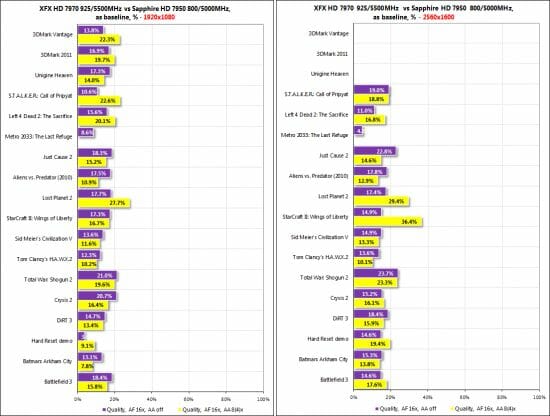
AMD has managed to position its two top-end products very accurately: the Radeon HD 7970 is indeed worth the extra $100 compared to the Radeon HD 7950. The average difference across all the tests is 15-16% at 1920×1080 and 16-19% at 2560×1600. The difference is small in Metro 2033: The Last Refuge and large in Total War: Shogun 2, StarCraft II: Wings of Liberty and Lost Planet 2.
Now let’s compare these cards when both are clocked at the same frequencies of 925/5500 MHz.
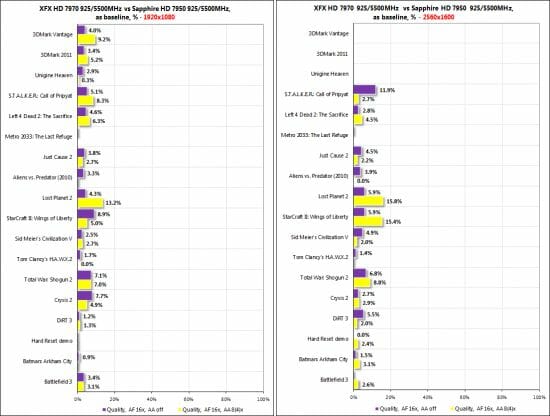
The gap is much smaller now: 3-4% on average at both resolutions. When clocked at the same frequencies as the HD 7970, the Radeon HD 7950 delivers almost the same performance in such games as Metro 2033: The Last Refuge, Tom Clancy’s H.A.W.X. 2, DiRT 3, Hard Reset and Batman: Arkham City. The HD 7970 is still faster in Total War: Shogun 2, StarCraft II: Wings of Liberty and Lost Planet 2, though.
The Radeon HD 7950 can perform even faster, however. Here’s how it does at 1100/7360 MHz:
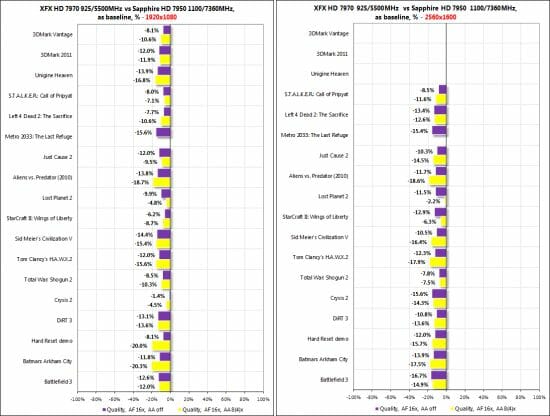
Of course, the HD 7970 can be overclocked as well, and perhaps even better than the HD 7950, but the latter card should still be given credit for high overclockability at a cheaper price.
The last pair of diagrams compares the Radeon HD 7950 3GB (800/5000 MHz) and the GeForce GTX 580 3GB (772/1544/4008 MHz):
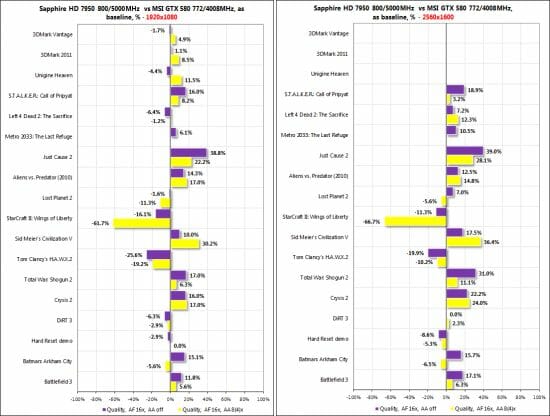
The GeForce GTX 580 comes out the winner in StarCraft II: Wings of Liberty and Tom Clancy’s H.A.W.X. 2 and enjoys some advantage in Lost Planet 2 and DiRT 3. The Radeon HD 7950, on its part, is faster in S.T.A.L.K.E.R.: Call of Pripyat, Just Cause 2, Aliens vs. Predator (2010), Sid Meier’s Civilization V, Total War: Shogun 2, Crysis 2 and Battlefield 3. The rest of the tests do not reveal a clear winner. We guess considering the same price of the two cards and the incomparably higher overclocking potential of the Radeon HD 7950, the choice between the two products is obvious.
Here is a table with the detailed test results:
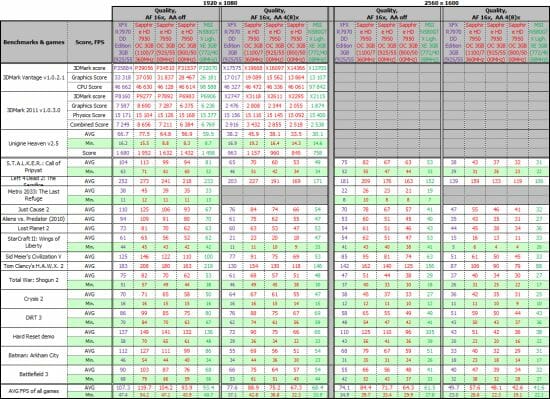
Conclusion
The Radeon HD 7950 3GB seems to be an even more attractive product than the recently released Radeon HD 7970 3GB. Being more affordable, it can be overclocked to deliver higher performance while the $100 difference in price can be spent for a better cooler. This is good news for overclockers, of course, but even at its default clock rates the Radeon HD 7950 is competitive against Nvidia’s previous-generation flagship GeForce GTX 580 3GB across a number of tests and benchmarks. Still, we want to stress it once again that the Radeon HD 7950 is meant for overclocking. Its Tahiti Pro processor and fast graphics memory feature tremendous overclocking potential that can be put to use easily.
Sapphire has come up with an excellent version of Radeon HD 7950 3GB that combines the abovementioned advantages with an efficient and quiet cooler (perhaps the quietest among all original GPU coolers we’ve tested so far). The Sapphire Radeon HD 7950 OC 3GB is factory overclocked but can be overclocked even more. And it comes with sufficient accessories at a close-to-recommended price. Therefore, we are proud to award Sapphire Radeon HD 7950 OC 3 GB graphics cards with our Editor’s Choice title:

While we are fully satisfied with our today’s hero, we are still looking forward to testing more Tahiti-based products from Gigabyte, PowerColor, MSI, ASUS and VTX3D. Stay tuned!